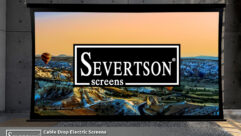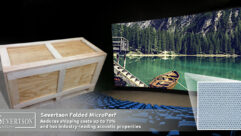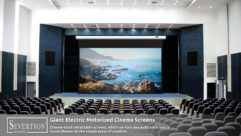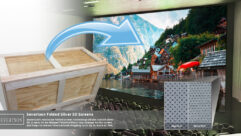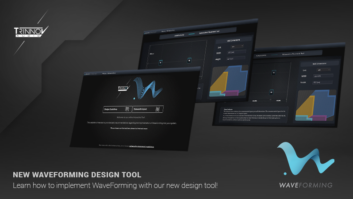
Technology Showcase: Plasma Screens in Houses of Worship
Jan 1, 2008 12:00 PM,
By Jay Ankeney
Flatpanels display spiritual messages.

NEC PlasmaSync 42XP10
To express the glory of their congregations’ faith, the interiors of houses of worship have traditionally been adorned with visual splendor. Today, the impact of that splendor is often enhanced by suspended flatpanel video displays hovering over the congregation, dispersed among the aisles, or installed in ancillary overflow and teaching rooms. Even digital signage is becoming a more common sight in the foyers and vestibules of houses of worship that use it to convey event scheduling and community activities to the penitent as they enter or leave. A growing number of church, synagogue, or temple members are even endowing their houses of worship with the latest video-presentation screens — just as people in past years used to donate stained-glass windows or murals that reflected their commitment to their faith.
Although there are several options for flatpanel displays and digital-projection systems these days, many feel the imagery seen on a plasma screen is best suited for moving video when brightness under ambient light and deep blacks in the contrast scale are of prime concern. New technologies that reduce concern over pixel burn-in are even making plasma displays appropriate for data and text, useful for presenting the lyrics of hymns or the words of a pastor’s presentation.
The increased interest in plasma displays is reflected in the overall growth of plasma sales. The market research firm iSuppli reports that the 288,351 unit sales of plasma screens in North America in 2005 grew to 344,468 in 2006, and at press time it predicted sales would top 426,000 plasma units in 2007. TFCinfo is a firm that concentrates on analyzing specific distribution channels of the advanced display market segment both by tracking monthly sales of advanced display products through wholesale distributors and by conducting custom market-research projects for display-industry participants. In its 2007 survey of American churches, TFCinfo reports that 29.9 percent of the electronic displays employed in houses of worship with more than 1,000 seats are plasma screens, a percentage not much smaller than the 34.8 percent of the displays using LCD technology. When churches already using sophisticated AV equipment were asked whether they were exploring purchasing or adding video equipment to their current systems, 46.7 percent expressed interest in plasma displays compared to 36.1 percent looking at LCDs (excluding computer monitors).
Much of this trend can be attributed to the growing popularity of very large displays that are making their way into home theaters and commercial venues such as major hotels, sports bars, shopping malls, and airports. Alfred Poor, senior research associate with Pacific Media Associates, says, “The 50in.-to-54in. segment of the plasma market is still holding onto its share for the most part, as LCDs do not yet have a cost advantage in this size range. LCDs do have an advantage in the consumer space in that they can produce true 1080p resolution more easily than plasma can, but for the professional [commercial] markets, this higher resolution is not as important. For example, for digital signage or presentations, lower-resolution displays are totally adequate for the application.”
Ever since Donald L. Bitzer, H. Gene Slottow, and graduate student Robert Willson invented plasma-display technology at the University of Illinois at Urbana-Champaign in 1964, the growth of this type of display has been rapid, with some of the biggest advances happening quite recently. Fujitsu claimed the world’s first 21in. full-color plasma display in 1992, and Pioneer started selling the first plasma television to the public as recently as 1997. By the end of 2007, although manufacturers such as Toshiba and Philips had dropped out of the plasma market entirely, the remaining proponents of this technology had expanded their scope all the way up to the 103in. plasma display manufactured by Matsushita Electrical Industries and sold in the United States by Panasonic, and all the way down to new 32in. models intended as CRT replacements. Many plasma displays even have built-in matrix capabilities so they can be used in videowall configurations to present an image large enough to be seen from the rear pews.
Technology Showcase: Plasma Screens in Houses of Worship
Jan 1, 2008 12:00 PM,
By Jay Ankeney
Flatpanels display spiritual messages.

Pioneer Electronics PDP-507CMX
THE MARKET
Here is a look at some of the latest and greatest plasma displays that these top manufacturers recommend as most suited to installation in houses of worship.
Fujitsu has recently introduced its P50FT00AUB 50in. Aviamo 1080p plasma TV with dual HDMI inputs and AVM-III video processing. Featuring a stylish design by Shigeru Uchida and rich contours, the plasma offers all digital-to-digital conversion from signal capture to onscreen display, and it comes with a three-year inclusive warranty. For a larger display, Fujitsu offers the P65FT00AUB 65in. Aviamo 1080p plasma TV with the ability to display virtually any video source, including the output from a computer. Like its 50in. sibling, the P65FT00AUB features advanced color management to enhance the primary hues and an ambient-light sensor to adjust the screen’s relative brightness based on the surrounding room light.
Because many houses of worship will be looking to replace their relatively small-screen CRT displays in classrooms and meeting centers, many will be interested to know that LG Electronics announced a new cost-efficient 32in. plasma display last November at The International Hotel/Motel & Restaurant Show in White Plains, N.Y. As the first new 32in. plasma on the market, this 480p display should start shipping later this year. For the main sanctuary, LG Electronics recommends its 60PC1DC 60in. integrated plasma HDTV, which includes LG’s exclusive XD Engine and takes the low resolution of analog signals to near-HD levels by improving brightness and contrast, enhancing color, and reducing signal noise. LG Electronics’ plasma displays have nine commercial-grade settings to allow professional control of their image display and functionality. These include new public-display settings that can be cloned with the company’s TVLink-Loader controller so they can be set on one display and uploaded to multiple other 42in., 50in., or 60in. LG plasma sets. To correct potential burn-in on the screen, the 60PC1DC is equipped with image inversion to let a negative image resurrect the screen’s pixels.
NEC‘s new line of plasma displays includes the 42in. PlasmaSync 42XP10. Featuring a variety of inputs — including DVI with HDCP, videowall capability, and remote image control — this display is designed to provide maximum flexibility for a house of worship. For even more screen real estate, NEC also offers the 60in. PlasmaSync 60XP10 with 1366×768 resolution. The advanced video processing in the 60XP10 allows for optimized interpolation of moving images for a smoother picture with greater detail and deeper blacks. Its enhanced split-screen feature allows two sources to be displayed on the screen with each resulting window offering multiple configurations and size options. Thanks to the built-in image-matrix capabilities of both the 42XP10 and the 60XP10, incoming video can be split into quadrants up to a 5×5 plasma wall, in addition to vertical and other configurations.
Able to claim the largest commercially available plasma display shipping over the past year, Panasonic would give any house of worship a video screen worthy of reverence with its 103in. TH-103PF9UK. With a predicted life of 100,000 hours until it reaches half its original brightness, the TH-103PF9UK is capable of running 7 hours a day for more than 40 years. Equipped with three interchangeable slots, the 103in. screen gives users a flexible system by making a wide variety of optional plug-in boards available. These can include Wi-Fi capability (the TY-FB10WPU wireless presentation board) and composite/component inputs (the TY-42TM6Y video terminal board). With 1920×1080 resolution, this giant-screen plasma runs in Super Cinema Mode, providing true HD with a progressive scan, and it comes with various unique professional features such as dual-picture mode, digital zoom, and a built-in videowall image enlarger. Of course, as one of the largest manufacturers of plasma screens, Panasonic offers a full range of models in sizes ranging from 37in. to 65in.

Runco XP-65DHD
The Pioneer Electronics PDP-507CMX plasma offers a host of powerful features. Additional image enhancement is provided by Pioneer’s First-Surface Pure Color Filter bonded directly to the glass to reduce ambient-light reflection, letting Pioneer’s new Pure Drive Pro image-processing engine deliver a clear and natural image quality in any installation setting. If you need a 60in. screen with professional features, the Pioneer PDP-607CMX comes with RS-232C terminals so it can be controlled by a computer. According to Pioneer, its plasmas were the first to provide expansion slots for professional applications and the first to be certified by Microsoft Windows Hardware Qualification Labs (WHQL). They also offer the capability to provide scrolling text in a picture-in-picture overlay without external processing.
With its recent acquisitions, Planar Systems now includes two brands of plasma displays: Runco and the more broadly marketed Vidikron. Runco is expanding its PlasmaWall product line with the addition of the new Runco XP-65DHD plasma monitor, its largest and highest-resolution plasma at 65in. diagonal and 1920×1080 (1080p) native resolution. The XP-65DHD qualifies for THX-certification status. The XP-65DHD boasts sophisticated 16-bit digital video processing resulting in 4,096 steps of graduation for seamless images, completely devoid of the “solarization” and stair-stepping characteristics previously associated with digital flatpanel displays. The Runco line also includes the XP-50DHD, a 50in. display monitor offering full-1080p resolution that just started shipping in December. The “DHD” in both the 65in. and 50in. model names indicates that they have external video-processing modules, providing more flexible installation options.

Vidikron VP-4200 PlasmaView
The Vidikron family is topped by its VP-6500VHD, featuring what Vidikron claims as its brightest picture, best contrast ratio, deepest black levels, and most accurate colorimetry yet available. Although the Vidikron VP-6500VHD is a 65in. screen, it is only 5in. thick. Like its Runco sibling, the VP-6500VHD is THX-certified. For the best price and performance, the Vidikron line includes the 42in. VP-4200 PlasmaView monitor (1024×768) for 720p presentations. The 42in. VP-4200 benefits from an outboard HD tuner along with IR and discrete RS-232 control.
The Maxent brand is the value-oriented line of plasma displays for the consumer market now offered by Regent USA. Its 42in. MX-42HPT51 sports an attractive bezel and offers what the company terms a “surreal” video picture for high-definition viewing, featuring a contrast ratio of 8000:1 along with generous connectivity options. The MX-42HPT51 has a native resolution of 1024×768 and brightness rated at 1300cd/m2. Its MotionDSC video processor provides 3:2 pulldown, the company’s Intelligent Image Scaling (IIS) Engine, and black-level extension. For a larger screen, Regent USA recommends its new 50in. MX-5020HPM with 1366×768 resolution, a contrast ratio of 10,000:1, and a brightness level of 1200cd/m2. Maxent plasma monitors feature an RS-232 port for remote control, a 3D Y/C digital comb filter, and a wide array of connectivity options including HDMI with HDCP, RGB input, composite and S-Video inputs, and SD/HD component video inputs.
According to Samsung, “[The PPM63M7F 63in. plasma display is] a monitor with as much impact as your message.” It includes Digital Natural Image enhancement (DNIe) Pro third-generation proprietary image-enhancement technology for the clearest images and, with 13-bit processing, the PPM63M7F is equipped to display 549.8 billion colors at a 10,000:1 contrast ratio while also offering multiple anti-burn-in strategies to preserve the purity of the display. The supplied Multi Display Control (MDC) software allows administrators to control up to 10 PPM63M7F monitors simultaneously from a single PC, and it has a built-in videowall processor to let multiple screens work together.

Vizio VP50
Although Sony is planning to withdraw from the plasma market, it does recommend its 50in. FWD50PX3 as a balance between high product performance and price competitiveness. With a contrast ratio of 15,000:1, the FWD50PX3 has a 1365×768 (WXGA) native resolution, a picture-and-picture (PAP) mode, and central control and serviceability via a built-in LAN. Along with a screen-saver feature and multiple display formats (1×2, 1×3, 1×4, 2×1, 3×1, 4×1, 2×2, 3×3, 4×4), the FWD50PX3 also features the ability to be used in a multi-display videowall configuration for even more expansive visual imagery. New on the FWD50PX3 is an improved color algorithm to prevent the kind of color banding that can sometimes plague plasma displays. But by the middle of this year, Sony will have transitioned out of most of its plasma production in favor of LCD designs, leaving this 50in. model the only plasma screen planned for its catalog at this time.
Last year, DisplaySearch — a leading provider of information, consulting, and conferences on the display supply chain — named Vizio the number-one-selling brand of flatpanel HDTVs (both LCD and plasma) in the United States. Vizio’s 60in. plasma display, the VM60PHDTV10A, gets its sleek look from an extraordinarily thin bezel that lets it sit directly on a sanctuary’s wall. With a 7000:1 contrast ratio for deep blacks and 10-bit color processing thanks to Vizio’s Color Vision technology, the VM60PHDTV10A comes with downward-firing loudspeakers for cases in which the house of worship’s own audio system is not being used. Vizio’s 50in. VP50 can produce exceptionally bright 1500cd/m2 images at a 1365×768 native resolution for 720p presentations at an unprecedented 15,000:1 contrast ratio. The VP50 plasma can display 6,144 shades of gray in 1.07 billion colors for a brilliantly colorful picture.
Jay Ankeneyis an industry consultant and former TV network engineer living in the Los Angeles area.
For More Information
Fujitsu
www.plasmavision.com
LG Electronics
www.lgcommercial.com
Panasonic
www.panasonic.com/business
Pioneer Electronics
www.pioneerelectronics.com
Planar Systems
www.planar.com
Regent USA
www.maxentusa.com
Runco
www.runco.com
Vidikron
www.vidikron.com
Samsung
www.samsung.com
Vizio
www.vizio.com


